
Broaching is a machining process that uses a toothed tool, called a broach, to remove material. Broaching is used when precision machining is required, especially for odd shapes. Commonly machined surfaces include circular and non-circular holes, splines, keyways, and flat surfaces. Typical workpieces include small to medium-sized castings, forgings, screw machine parts, and stampings. Broaching is usually favored over other processes when used for high-quantity production runs.
The process depends on the type of broaching being performed. Surface broaching is very simple as either the workpiece is moved against a stationary surface broach, or the workpiece is held stationary while the broach is moved against it.
Internal broaching is more involved. The process begins by clamping the workpiece into a special holding fixture, called a workholder, which mounts in the broaching machine. The broaching machine elevator, which is the part of the machine that moves the broach above the workholder, then lowers the broach through the workpiece. Once through, the broaching machine’s puller, essentially a hook, grabs the pilot of the broach. The elevator then releases the top of the pilot and the puller pulls the broach through the workpiece completely. The workpiece is then removed from the machine and the broach is raised back up to reengage with the elevator. The broach usually only moves linearly, but sometimes it is also rotated to create a spiral spline or gun-barrel rifling.











